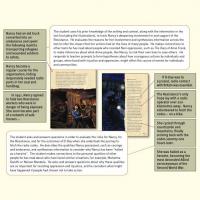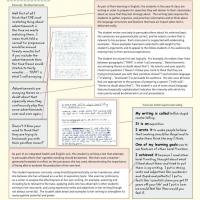By the end of year 8
The reading standard
The writing standard
The reading standard
By the end of year 8, students will read, respond to, and think critically about texts in order to meet the reading demands of the New Zealand Curriculum at level 4. Students will locate, evaluate, and synthesise information and ideas within and across a range of texts appropriate to this level as they generate and answer questions to meet specific learning purposes across the curriculum. The text and task demands of the curriculum are similar for students in year 7 and year 8. The difference in the standard for year 8 is the students’ increased accuracy and speed in reading a variety of texts from across the curriculum, their level of control and independence in selecting strategies for using texts to support their learning, and the range of texts they engage with. In particular, by the end of year 8, students need to be confidently and deliberately choosing the most appropriate strategies for reading in different learning areas.
Key characteristics of texts that students read at this level
The texts that students use to meet the reading demands of the curriculum at this level will often include:
- elements that require interpretation, such as complex plots, sophisticated themes,and abstract ideas
- complex layers of meaning, and/or information that is irrelevant to the identified purpose for reading (that is, competing information), requiring students to infer meanings or make judgments
- non-continuous text structures and mixed text types
- sentences that vary in length, including long, complex sentences that contain a lot of information
- adverbial clauses or connectives that require students to make links across the whole text
- academic and content-specific vocabulary
- words and phrases with multiple meanings that require students to know and use effective word-solving strategies to retain their focus on meaning
- metaphor, analogy, and connotative language that is open to interpretation
- illustrations, photographs, text boxes, diagrams, maps, charts, and graphs, containing main ideas that relate to the text’s content.
Such texts will include both fiction and non-fiction in electronic and print media. They may be published individually (for example, as novels, reference materials, textbooks, or modified scientific and historical texts) or in collections (for example, age-appropriate newspapers, magazines, and journals, including the School Journal). Poetry, plays, procedural texts, and extended instructions (for example, in science and mathematics) often appear in collections or textbooks.
Illustrating the standard
The student by the end of year 8 does this with greater independence and confidence as well as describing the impact of these actions.
'The Gestapo’s Most Wanted' (School Journal, Part 4 Number 2, 2009)
Noun frequency level: 12–14
By the end of year 8, students are required to use a range of fiction and non-fiction texts to locate, evaluate, and synthesise information and ideas in order to meet the reading demands of the curriculum, drawing on the knowledge, skills, and attitudes described for the end of year 8 in the Literacy Learning Progressions. The curriculum tasks will also involve the students in generating their own questions as well as answering questions from the teacher.
As part of their learning in social studies, the students in a year 7 and 8 class are inquiring into how individuals respond to community challenges. The students are reading a wide variety of non-fiction texts in order to explore the personal qualities that drive people to courageously put their lives at risk to change the course of events when faced with oppression and injustice.
'The Gestapo’s Most Wanted' is a biography that recounts the dangerous role played by Nancy Wake, a young New Zealand-born woman who served with the French Resistance in the Second World War and became a secret agent for the Allied forces. This is a longer text that deals with some complex themes, such as resistance, endurance, and courage.
The teacher chose 'The Gestapo’s Most Wanted' because of its complex themes and historical setting. Students need to evaluate and synthesise information to understand the importance of the personal qualities of Nancy Wake and of other people who have changed the course of events. The subheadings and the italicised introduction help the students to set up an expectation for the reading.
This example illustrates aspects of the task and text and demonstrates how a student engages with both task and text to meet the reading demands of the curriculum. A number of such examples would be used to inform the overall teacher judgment for this student.
Return to top
The writing standard
By the end of year 8, students will create texts in order to meet the writing demands of the New Zealand Curriculum at level 4. Students will use their writing to think about, record, and communicate experiences, ideas, and information to meet specific learning purposes across the curriculum. The text and task demands of the curriculum are similar for students in year 7 and year 8. The difference in the standard for year 8 is the students’ increased accuracy and fluency in writing a variety of texts across the curriculum, their level of control and independence in selecting writing processes and strategies, and the range of texts they write. In particular, by the end of year 8, students need to be confidently and deliberately choosing the most appropriate processes and strategies for writing in different learning areas.
Key characteristics of students' writing at this level
Students will write for a range of different purposes on topics and themes across the curriculum at this level, selecting and applying a process appropriate to the task and drawing on the knowledge, skills, and attitudes that will help them achieve their purpose. The knowledge, skills, and attitudes expected at this level, including those needed for spelling and punctuation, are described in the Literacy
Learning Progressions. Students will independently write texts, choosing language and a clear and logical text structure that they have deliberately chosen for their specific audience and purpose, drawing on their knowledge of the conventions for particular text forms (for example, when writing personal narratives, poems, arguments, feature articles, character profiles, research reports, essays, responses to literature, and short answers).
These texts will include, when appropriate:
- content that is concise and relevant to the curriculum task and that often includes detail and/or comment supporting or elaborating on the main points
- paragraphs within which the ideas are clearly related and links within and between paragraphs
- grammatically correct sentences
- words and phrases that are appropriate to the topic, register, and purpose, including expressive, academic, and subject-specific vocabulary.
Illustrating the writing standard
The students by the end of year 8 deliberately include appropriate text features as they think about and communicate their ideas and experiences in order to complete the curriculum task.
‘No advertisements’ and 'Selfish stupid smoke selling'
By the end of year 8, students are required to create a variety of texts in order to think about, record, and communicate experiences, ideas, and information across the curriculum. To meet the standard, students draw on the knowledge, skills, and attitudes for writing described in the Literacy Learning Progressions for students at this level.
These examples illustrate aspects of the tasks and texts and demonstrate how each student engages with both task and text to meet the writing demands of the curriculum. A number of such examples would be used to inform the overall teacher judgment for these students.
Published on: 19 Oct 2009
Return to top



